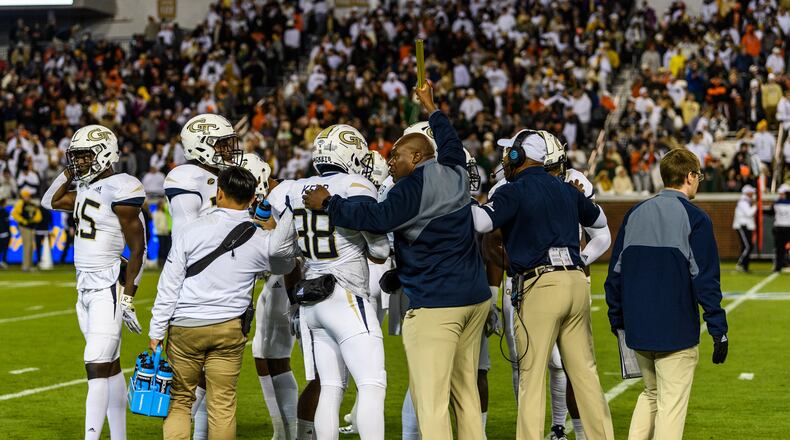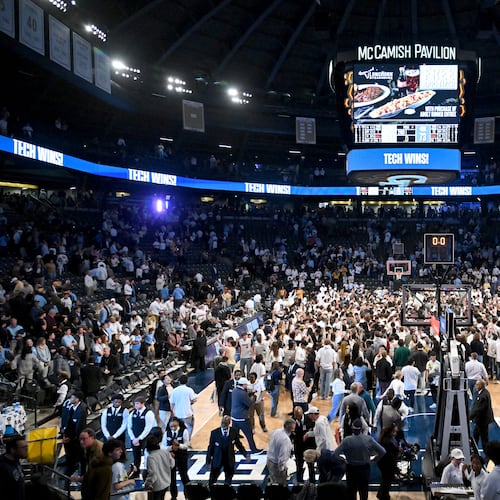Derrick Moore has delivered pregame devotions and pep talks to the Georgia Tech football team for years. He has learned that not everything sticks.
“I’m never sure of anything I put out there, if they’re going to take it,” said Moore, Tech’s character-development coach. “You’re dealing with 18-to-22-year-olds.”
Moore, though, has hit home with a relay baton, a cylindrical metaphor that players say has helped bind the Yellow Jackets in their three-game winning streak. They’ll go for their fourth Saturday against Virginia at Bobby Dodd Stadium.
“To me, the baton means that we have to work together as a team,” B-back Jerry Howard said. “That not just one person can win the race. Everybody has to be involved with the race.”
Sideline props have become the rage in college football, popularized by Miami’s turnover chain. Tech’s relay baton perhaps carries a little more resonance, as it is a symbol of the team as opposed to the celebration of an individual.
“I think the kids have really embraced it,” said John Sisk, Tech’s strength-and-conditioning coach.
Baton 1.0 was actually a muscle massaging stick, introduced before the Virginia Tech game. To go back a few steps, Moore has been with the Jackets since 2002, leading devotionals, giving locker-room pep talks and exhorting players on the sidelines. His game-day messages are synthesized from coach Paul Johnson’s post-practice addresses to the team.
“And so I’ll take it and put it in my own terms and so the kids, when they hear it from me, it’s really them hearing coach Johnson but hearing it my own language,” Moore said.
Before the Virginia Tech game, the Jackets were coming off a loss to Duke in which the offense, defense and special teams all had a hand in the defeat. Johnson told the team that it needed to improve on offense, defense and special teams and that Tech couldn’t win without all three units contributing. Moore’s mind began to percolate.
He was at home when he saw a video clip of Usain Bolt roaring through the anchor leg of a 4x100-meter relay. Something clicked. At the devotional before the Hokies game, he brought Jaquan Henderson, Anree Saint-Amour, Brant Mitchell and Qua Searcy to the front of the room and encouraged the Jackets to think of their respective units as legs in a relay race, with special teams starting off, giving way to the defense and then passing off to the offense.
To demonstrate, the four players, representing special teams (Henderson), defense (Saint-Amour and Mitchell) and offense (Searcy), exchanged the stick (on loan from the strength-and-conditioning staff) from one to the next.
“It made sense,” linebacker Jalen Johnson said. “Just having each team come together like a 4x1 team does to get the main goal.”
During the game, he held onto the stick and, during changes in possession, held it aloft and reminded players of their obligation to their teammates to continue the relay. The Jackets won 49-28, with all three phases contributing, and the baton was off and running.
After the game, Sisk ordered Moore an actual relay baton. (It’s gold, naturally.) The next week, when Tech played North Carolina, Moore was at one end of the sideline when he heard people calling him by his nickname (“D-Mo”) loudly and repeatedly. Players on the kickoff coverage team were huddled up on the sideline and were waiting for him to send them off onto the field.
“That’s when I knew they bought in,” Moore said.
At devotionals at the team hotel and again before games in the locker room, every player receives and hands off the baton, communicating the message that not only does each unit bear responsibility to the rest of the team, but also each player. Moore picks a player to carry it from the team hotel to the stadium. Before the Miami game, it was Mitchell. Safety Juanyeh Thomas carries the baton onto the field.
“He takes so much pride in playing at a high level, and he wanted to carry it out,” Moore said of Thomas. “He’s a kid that says, ‘Put it on my back. I will own this.’”
During the game, Moore is the baton’s caretaker.
“I hold it the whole game,” Moore said. “I cannot put the baton on the ground or they will go nuts.”
Whether coincidence or cause, all three phases have made meaningful contributions to Tech’s wins over Virginia Tech, North Carolina and Miami as the Jackets have turned the season around.
“Every possession that gets changed, whether it’s special teams, defense or offense, it all clicks together now,” punter Pressley Harvin said. “I really think that symbolism of that baton really helps us.”
About the Author
Keep Reading
The Latest
Featured



